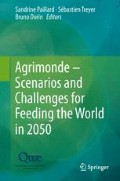Abstract
The Agrimonde foresight study enabled us to address questions that had not yet been formulated as such in mainstream scientific debates. Not that the facts reported or the assumptions put forward were entirely unpredictable or unknown; but they prompted the experts, followed by the various audiences to whom the results were presented, to consider the actions to be undertaken from a different point of view, primarily in relation to the type of future wished for—or not—in the decades to come. The value of baseline scenarios is not that they predict a sure future—which no one can actually anticipate as far ahead as 2050—but that they define the narrow path of possible futures that are likely to unfold if we fail to broaden our options now. Alternative scenario(s) can thus be mobilised to identify the objectives that we need to set when broadening the options explored. This has been the role of the Agrimonde 1 scenario, in contrast to the baseline scenario provided by Agrimonde GO.
Access this chapter
Tax calculation will be finalised at checkout
Purchases are for personal use only
Notes
- 1.
International Assessment of Agricultural Knowledge, Science and Technology for Development. The reports stemming from this global collective assessment were published in 2009 by Island Press; they are available at: http://www.agassessment.org.
- 2.
In 2008, the annual report on the state of development in the world, commissioned by the World Bank (World Bank 2008), was devoted to agriculture for the first time in 27 years.
- 3.
- 4.
Consultative Group on International Agricultural Research which coordinates the action of 15 international agronomic research centres created since the 1970s (http://www.cgiar.org).
- 5.
Global Partnership for Agriculture and Food Security currently being created following the June 2008 FAO summit on food, convened in reaction to the ‘food crisis’ at the beginning of that year, the summit organised in early 2009 in Madrid by the United Nations (http://www.ransa2009.org), and the Heads of State summit held in Rome in November 2009.
Author information
Authors and Affiliations
Corresponding author
Editor information
Editors and Affiliations
Rights and permissions
Copyright information
© 2014 © Éditions Quæ, 2014
About this chapter
Cite this chapter
Hubert, B., Caron, P., Guyomard, H. (2014). Conclusion. In: Paillard, S., Treyer, S., Dorin, B. (eds) Agrimonde – Scenarios and Challenges for Feeding the World in 2050. Springer, Dordrecht. https://doi.org/10.1007/978-94-017-8745-1_12
Download citation
DOI: https://doi.org/10.1007/978-94-017-8745-1_12
Published:
Publisher Name: Springer, Dordrecht
Print ISBN: 978-94-017-8744-4
Online ISBN: 978-94-017-8745-1
eBook Packages: Biomedical and Life SciencesBiomedical and Life Sciences (R0)

